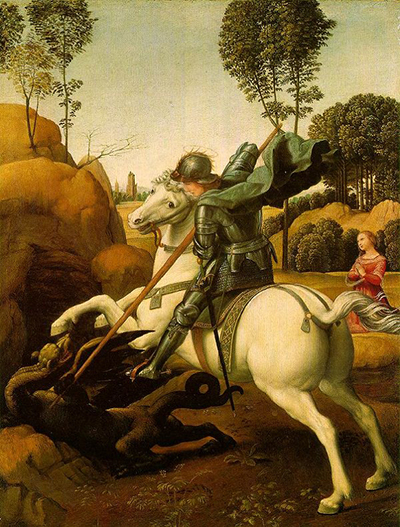St George and the Dragon refers to a small painting developed by Raphael, an Italian Renaissance artist, created between 1504 and 1506, and currently resides in Washington DC in the National Gallery of Art.
The saint puts on the blue garter according to the English Order of Garter, which reflects the award of this decoration by King Henry VII of England to Guidobaldo da Montefeltro, Raphael's patron in 1504. St George and the Dragon masterpiece was commissioned by the Duke of Urbino, either to Sir Gilbert Talbot, the English envoy who brought Urbino the regalia or to King Henry himself. The commemoration of a minor Italian leader reflected how much Henry appreciated the cultural status of Renaissance Italy just like any other diplomatic purpose. St George and the Dragon painting combines chivalry and Christianity, and it is suitable for the occasion; just like his dad, Guidobaldo da Montefeltro was a condottiere or a manager of a mercenary soldiers' band.
In many ways, Saint George and the Dragon painting reveals most of the Renaissance ideals and themes that Raphael strove hard to master. For example, the horse on which Saint George sits on is an excellent indication of naturalistic musculature: especially the leg and lower neck areas that show the skin of the animal and the muscle breath as well. Moreover, just like most of his other artwork, the symbolic narrative is typically Christian in nature.
The background of the piece is dominated by Peruginesque tones and light, and clear blue sky with Saint George himself sitting on a dazzling red saddle, another evidence of the painter's anti-da Vinci inclination to use bright, evocative colours. As a result, St. George resembles the equine statues of ancient Roman. While this painting appears more normative than exclusive, it captures the eye due to its striking illustration of the dragon: probably more than any other figure in the painting, the dragon depicts a palpable mindset, in this case, hatred and aggression.
By 1627, Saint George and the Dragon artwork belonged to the 3rd Earl of Pembroke, William Herbert, and it was residing in Wilton House, Wiltshire. Either the 4th or 3rd earl presented the painting to King Charles 1. After the English Civil War, the painting was sold in one of the Royal Collection sales at Somerset House, London on December 19, 1651. Later, the piece was in France. The artwork was later highlighted in the Pierre Crozat compendium acquired by Catherine II of Russia in 1772 through Diderot's mediation. For one century and a half, the painting was in the Imperial Heritage Museum and was among the most famous paintings in the Tsars' collection.
In March 1931, the painting was part of the Hermitage paintings Soviet sale and was acquired by Andrew Mellon. Andrew gave the painting to the National Gallery of Art based in Wahington, DC as part of his donation to the cultural centre. This work as well as other foundational paintings, including artworks by Titian, Sandro Botticelli and Jan Van Eyck, contributed in placing the National Gallery centre among the most important collections of Renaissance artwork.




